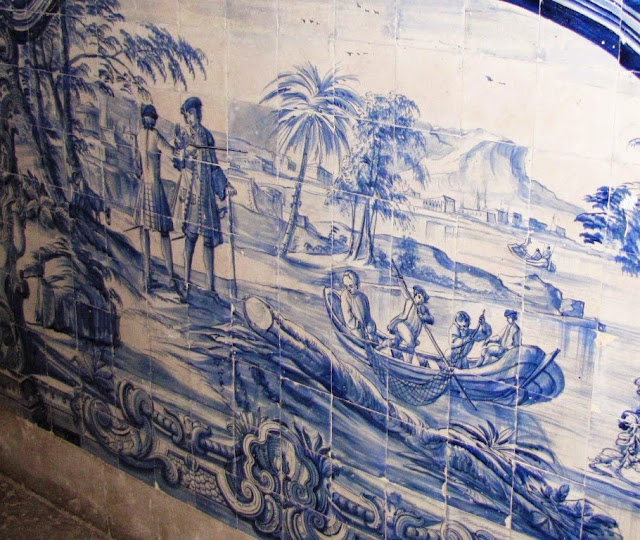Founded in the second half of the 16th century, the building was totally rebuilt at the end of the 17th century by the architect João Antunes. Even though it was never used as aplace of worship, it still preserves, under its modern dome, a majestic nave with a polychrome marble decoration typical of the Portuguese Baroque architecture. Being an icon of Lisbon’s cityscape and having a privileged location, as it overlooks the city’s historic center and the river Tagus,
The traditional Feira da Ladra (flea market) is held next on Tuesdays and Saturdays.
Contents edited by DDCI.
Address: Campo de Santa Clara 1100-471 Lisboa
GPS: Lat: 38.71499137592085 Long:-9.124671220779419
Phone(s): +351 218 854 820 Fax(s): +351 218854839
Originally a church, in the 20th century it was converted into the National Pantheon in which important Portuguese personalities are buried. It is located in the Alfama neighborhood, close to another important Lisbon monument, the Monastery of São Vicente de Fora.
Originally a church, in the 20th century it was converted into the National Pantheon in which important Portuguese personalities are buried. It is located in the Alfama neighborhood, close to another important Lisbon monument, the Monastery of São Vicente de Fora.
TERRACE OF THE NATONAL PANTHEON -
PANORAMIC VIEW
THE TOMB OF AMÁLIA RODRIGUES
1 - FLEA MARKET
( CAMPO DE SANTA CLARA )
4 - SÃO VICENTE DE FORA MONASTERY
The Church or Monastery of São Vicente de Fora; meaning "Monastery of St. Vincent Outside the Walls" is a 17th-century church and monastery in the city of Lisbon, Portugal. It is one of the most important monasteries and mannerist buildings in the country. The monastery also contains the royal pantheon of the Braganza monarchs of Portugal.
The church of the Monastery has a majestic, austere façade that follows the later Renaissance style known as Mannerism. The façade, attributed to Baltazar Álvares, has several niches with statues of saints and is flanked by two towers (a model that would become widespread in Portugal). The lower part of the façade has three arches that lead to the galilee (entrance hall). The floorplan of the church reveals a Latin cross building with a one-aisled nave with lateral chapels. The church is covered by barrel vaulting and has a huge dome over the crossing. The general design of the church interior follows that of the prototypic church of Il Gesù, in Rome.
The beautiful main altarpiece is a Baroque work of the 18th century by one of the best Portuguese sculptors, Joaquim Machado de Castro. The altarpiece has the shape of a baldachin and is decorated with a large number of statues. The church also boasts several fine altarpieces in the lateral chapels.
The Monastery buildings are reached through a magnificent baroque portal, located beside the church façade. Inside, the entrance is decorated with blue-white 18th-century tiles that tell the history of the Monastery, including scenes of the Siege of Lisbon in 1147. The ceiling of the room has an illusionistic painting executed in 1710 by the Italian Vincenzo Baccarelli. The sacristy of the Monastery is exuberantly decorated with polychrome marble and painting. The cloisters are also notable for the 18th-century tiles that recount fables of La Fontaine, among other themes.
The beautiful main altarpiece is a Baroque work of the 18th century by one of the best Portuguese sculptors, Joaquim Machado de Castro. The altarpiece has the shape of a baldachin and is decorated with a large number of statues. The church also boasts several fine altarpieces in the lateral chapels.
The Monastery buildings are reached through a magnificent baroque portal, located beside the church façade. Inside, the entrance is decorated with blue-white 18th-century tiles that tell the history of the Monastery, including scenes of the Siege of Lisbon in 1147. The ceiling of the room has an illusionistic painting executed in 1710 by the Italian Vincenzo Baccarelli. The sacristy of the Monastery is exuberantly decorated with polychrome marble and painting. The cloisters are also notable for the 18th-century tiles that recount fables of La Fontaine, among other themes.
TERRACES OF THE SÃO VICENTE DE FORA MONASTERY - PANORAMIC VIEW
ENTRANCE AND INSIDE THE MONASTERY
The cloisters ( next 5 photos )
THE ROYAL PANTHEON OF THE BRAGANZA
MONARCHS ( NEXT 5 PHOTOS )
TILES, TILES AND MORE TILES
( THE AMAZING WORLD OF TILE )




.jpg)











































.jpg)




























































































































































No comments:
Post a Comment